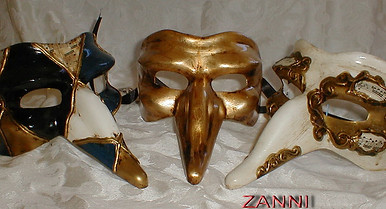Medico Della Peste
Also called Plague Doctor. With a exaggerated nose, and its nose is conventionally not only wider but curved downwards like be. Its name and peculiar form originates from the 16th Century and the unusual practices of a French physician by the name of Charles de Lorme, who would wear a full face mask with a hollow beak while treating plague sufferers. The Doctor is the local aristocrat. Extremely rich, he adores food and good wines. He is typically depicted as an elderly man who only knows nonsense.


Arlecchino
Arlecchino is also called Harlequin, identified by the famous Harlequin costume, with its multicoloured diamond pattern of red, green, and blue – representing clothes that are so old and patched as to have lost their original colour and material. He is a slow thinker who has a love interest in the servant girl Columbina, his lust for her only superseded by his desire for food or fear of his master.
Columbina
Popularised by a recurring character in the commedia dell’arte by the same name, the Columbina is traditionally a half mask adorned with an ornate variety of Jewels, feathers and fabrics. Often painted in gold or silver, it was held in place by either a ribbon or a stick. Colombina is a maidservant and the lover of Arlecchino. She dressed in a ragged and patched dress and was also known to wear heavy makeup around her eyes and carry a tambourine which she could use to fend off the amorous advances of Pantalone.


Pulcinella
It was usually black, often accompanied by loose-fitting white overalls, and featuring a more restrained variety of hooked nose that, while undoubtedly oversized, still kept a vestige of anthropomorphism. Pulcinella started out as an idiot simpleton servant, who developed into a complex , cunning character. Pulcinella was witty and crafty character but also full of common sense.
Zanni
The Zanni class of characters is another classic of the stage. Theirs is a half mask in leather, presenting themselves with low forehead, bulging eyebrows and a long nose with a reverse curve towards the end. The low forehead is also seen as a sign of stupidity. The Zanni are often the supporting characters in a comedian performance, often fulfilling similar societal roles as Arlecchino, though with smaller parts.


Gatto
Meaning ‘cat’ in Italian, the Gatto is unsurprisingly shaped like the face of a cat, with the characteristic pointy ears, narrow eyes and button nose. Perhaps more surprising is that it owes its genesis to the scarcity of cats in Venice during the days of the Republic, indicating that felines were prized above other species of domestic animal on account of their rarity.



